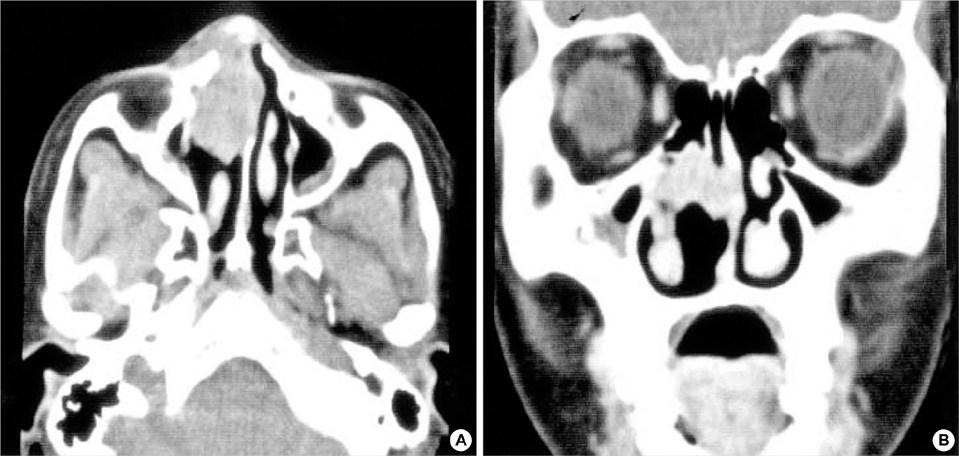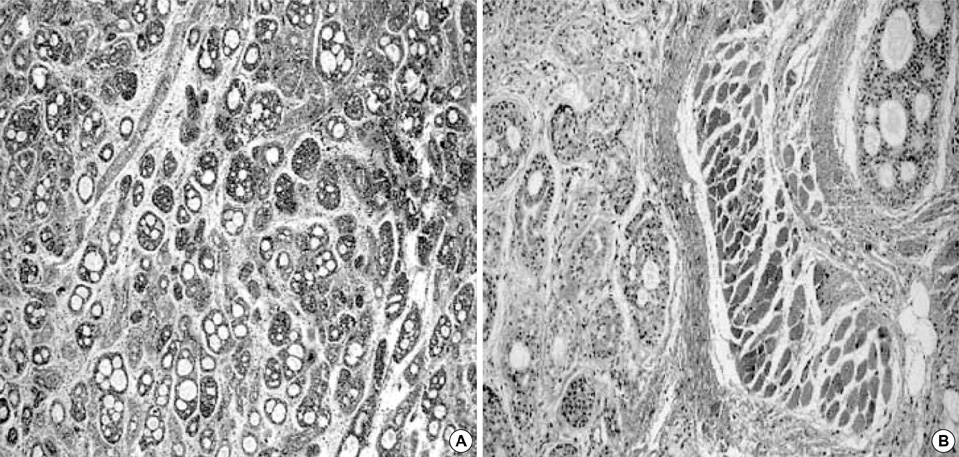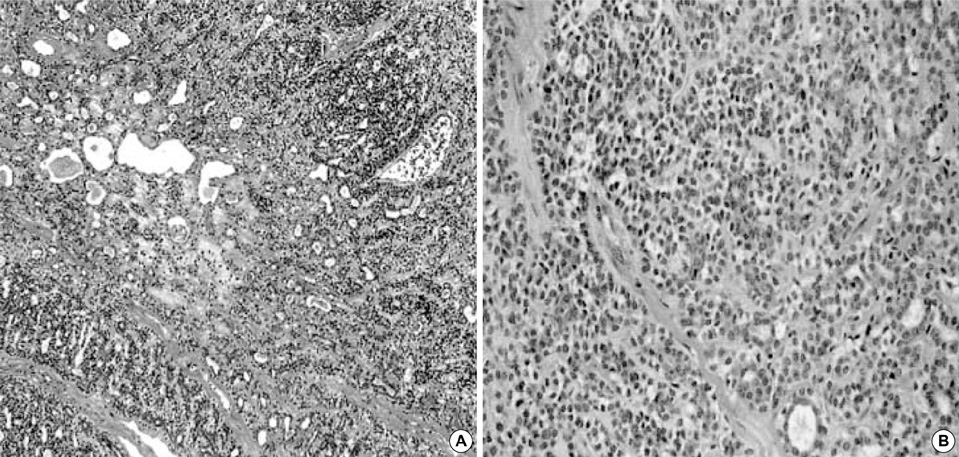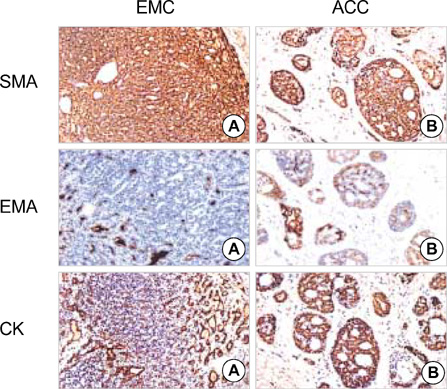J Korean Med Sci.
2004 Jun;19(3):462-465. 10.3346/jkms.2004.19.3.462.
A Hybrid Carcinoma of Epithelial-Myoepithelial Carcinoma and Adenoid Cystic Carcinoma in Maxillary Sinus
- Affiliations
-
- 1Department of Otolaryngology-Head and Neck Surgery, Anam Hospital, Korea University College of Medicine, Seoul, Korea. Kyjung@kumc.or.kr
- 2Department of Pathology, Anam Hospital, Korea University College of Medicine, Seoul, Korea.
- KMID: 1786829
- DOI: http://doi.org/10.3346/jkms.2004.19.3.462
Abstract
- Hybrid carcinoma of the salivary gland is a very rare entity that has been described only in the parotid and palate. The occurrence of a hybrid carcinoma of maxillary sinus has not been reported. The diagnosis of hybrid carcinoma is important particularly when the components of tumor have different biologic behaviors. Diagnosis and treatment require a high index of suspicion, especially when the tumor is an epithelial-myoepithelial carcinoma, pathological effort to look for a more aggressive accompanying tumor, and proper oncologic treatment. We describe a case of 26-yrold woman with a hybrid carcinoma composed of epithelial-myoepithelial carcinoma with an adenoid cystic carcinoma component (cribriform pattern) in the right maxillary sinus with a brief review of the relevant literature.
MeSH Terms
-
Adult
Carcinoma/*diagnosis/pathology
Carcinoma, Adenoid Cystic/*diagnosis/pathology
Female
Human
Immunohistochemistry
Maxillary Sinus Neoplasms/*diagnosis/pathology
Neoplasm Metastasis
Neoplasms, Glandular and Epithelial/*diagnosis/pathology
Neoplasms, Multiple Primary/*diagnosis/pathology
Prognosis
Recurrence
Treatment Outcome
Figure
Reference
-
1. Seifert G, Donath K. Hybrid tumours of salivary glands: definition and classification of five rare cases. Eur J Cancer B. 1996. 32B:251–259.
Article2. Seifert G, Donath K. Multiple tumours of the salivary glands: terminology and nomenclature. Eur J Cancer Oral Oncol. 1996. 32B:3–7.3. Croitoru CM, Suarez PA, Luna MA. Hybrid carcinomas of salivary glands: report of 4 cases and review of the literature. Arch Pathol Lab Med. 1999. 123:698–702.4. Snyder ML, Paulino AF. Hybrid carcinoma of the salivary gland: salivary duct adenocarcinoma adenoid cystic carcinoma. Histopathology. 1999. 35:380–383.
Article5. Spagnolo DV, Heenan PJ. Collision carcinoma at the esophagogastric junction: report of two cases. Cancer. 1980. 46:2702–2708.
Article6. Wanke M. Collision tumour of the cardia: case report. Virchows Arch Pathol Anat. 1972. 357:81–86.7. Batsakis JG, El-Naggar AK, Luna MA. Epithelial-myoepithelial carcinoma of salivary glands. Ann Otol Rhinol Laryngol. 1992. 101:540–542.
Article8. Tralongo V, Daniele E. Epithelial-myoepithelial carcinoma of the salivary glands: a review of literature. Anticancer Res. 1998. 18:603–608.9. Grenko RT, Abendroth CS, Davis AT, Levin RJ, Dardick I. Hybrid tumors or salivary gland tumors sharing common differentiation pathways? Reexamining adenoid cystic and epithelial-myoepithelial carcinomas. Oral Surg Oral Med Oral Pathol Oral Radiol Endod. 1998. 86:188–195.10. Nagao T, Sugano I, Ishida Y, Asoh A, Munakata S, Yamazaki K, Konno A, Iwaya K, Shimizu T, Serizawa H, Ebihara Y. Hybrid carcinomas of the salivary glands: report of nine cases with a clinicopathologic, immunohistochemical, and p53 gene alteration analysis. Mod Pathol. 2002. 15:724–733.
Article11. Chetty R. Intercalated duct hyperplasia: possible relationship to epithelial-myoepithelial carcinoma and hybrid tumours of salivary gland. Histopathology. 2000. 37:260–263.
Article12. Di Palma S. Epithelial-myoepithelial carcinoma with coexisting multifocal intercalated duct hyperplasia of the parotid gland. Histopathology. 1994. 25:494–496.
Article
- Full Text Links
- Actions
-
Cited
- CITED
-
- Close
- Share
- Similar articles
-
- Fine Needle Aspiration Cytology of Metastatic Epithelial-Myoepithelial Carcinoma of the Scalp: A Case Report
- A Case of Myoepithelial Carcinoma Originated from Inferior Turbinate
- A case of adenoid basal cell carcinoma in uterine cervix
- A case report of adenoid cystic carcinoma on maxillary antrum and infratemporal space
- A Case of Myoepithelial Carcinoma Arising in the Lacrimal Gland





